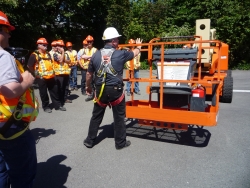
Training, for all of its virtue and value, is misunderstood by many. There are those that look upon training as nothing more than a necessary evil, a regulatory requirement to which our collective noses are strictly held. While others, though they may embrace the task of delivering training, do nothing to maintain it and in so doing, fail to reap the benefits.
Used to its fullest, training is the means by which to pass on methods, knowledge, and rationale designed to preserve life and limb. If these ideals are understood and embraced they can be a powerful motivator toward change in our perception, attitude, behavior and philosophy as they relate to safety. But how can we ensure that the virtuous ideals of safety are effectively conveyed through training?
Good training affects changes in perception and action by providing positive rationale in support of the training which in turn leads to the motivation to change. Quoting regulations and standards chapter and verse may be required from time to time, but don’t expect it to motivate or rationalize anything but sleep. The right kind of motivation and rationale lies in reasons behind not only the regulations but the information and methods advocated by the training. There is after all, a reason(s) for everything and adult trainees need to know them if they are expected to get anything out of the experience at all. Of course, trainers, supervisors and employers must be in on things as well otherwise it will all be for naught.
Providing rationale in support of regulations is not always easy as many people feel threatened by the scepter of regulation and the whole crime and punishment philosophy. Unfortunately, many trainers fall into the trap of allowing regulations to be perceived as a threat rather than what they are; lessons from the past. I prefer to rationalize the need to adhere to regulations by pointing out the good things in life that, by following reg’s, you can continue to enjoy. I also point out that regulations come about as a reaction to situations that have arisen in the past and caused a lot of grief; if there was no issue, there would be no regulation. If we are wise, we can use regulations to stand on the shoulders of the thousands that have gone down the wrong path before us and avoid their fate. Ultimately, regulations are a shield for your protection not a sword at your throat.
Any rationale provided in support of training must be of a positive nature meaning that it should motivate people toward the correct behavior rather than motivate them away from incorrect behavior. In other words training should exemplify and rationalize the right way to do things rather than how not to do it wrong. The motivational aspect is in illuminating the positive benefits of safety, health, quality of life etc. rather than the threat of non-compliance and punishment.
To exemplify this, whenever I am about to show trainees a three point mount/dismount from, a forklift for example, I ask if anyone in the group has ever had a back injury before demonstrating the procedure. Almost invariably someone or several will raise theory hand(s). I ask them how they injured themselves and if the injury has completely gone away, knowing that most back injuries linger on and on. Next I ask if the injury has altered how they live their lives, for batter of for worse and of course it always has and always for the worse. With that bit of background (pardon the pun) I proceed to demonstrate the three-point mount/dismount and rationalize it by pointing out that one of the most common injury claims for forklift drivers is a back injury usually sustained during mounting/dismounting of the unit. If you can see the benefits in living your life without a back injury this is an easy way to ensure that you get a chance to.
Now, I don’t always get total buy in and there are always the nay-Sayers but I get a lot better result than the do-it-cuz-the-regulations-say-so approach. In addition, I have noticed that by using these kinds if (rationalize and motivate) methods, the actions of the trainees spill over into their everyday lives and I see the correct actions being executed outside of the training program, which leads me to believe that understanding has been achieved and perhaps perceptions and actions have been altered toward the better.
So, training comes down to providing a means of motivating change through positive rationalization. That motivation is not found in any rule book, regulation or code, it is found in the hearts and minds of those that understand and embrace the rationale behind the action and that, is the Tao of training.
Rob Vetter
Director of Training
IVES Training Group
Did you enjoy this article? Sign up for our newsletter to receive more like this!